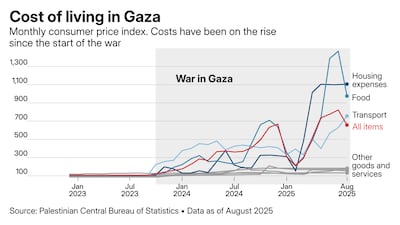It is almost two years since the start of the Gaza war, and the people in the Gaza Strip have been dealing with the loss of human lives and the expense of surviving.
The prices of goods and services have been on the rise since October 2023, and even though prices went down for a short period at the start of 2025, they quickly increased again, especially for housing expenses such as water, electricity and gas and food.
Measuring housing expenses and food prices
To measure the cost of living and the changes in the prices of goods and services purchased or acquired by households, the Palestinian Central Bureau of Statistics (PCBS) publishes the Consumer Price Index (CPI). The baseline is the prices of goods and services in 2018, where values above 100 mean higher costs. And as shown on this Chart of the Week, after five consecutive months of increasing prices between March and July, prices went down in August. However, they're still higher than they were two years ago.
The costs for a person to have a roof over their head and food to eat were constant throughout 2021 and 2022, with values of CPI of around 103 each year, but the numbers changed in 2023 and 2024. Housing expenses went from a CPI of 120.5 in 2023 to 231.89, an increase of 92.44 per cent, while food went from 116.80 to 379.24, a rise of more than 200 per cent.
The situation calmed down during the first two months of the year, when a ceasefire agreement came into place after 15 months of war.
However, that didn't last long for housing expenses, which in just two months reached a CPI of 1,018 and have remained constant, but costs could increase again given Israel's eviction order for all of Gaza city at the start of September. Additionally, accessing food has become a challenge for Gazans, and the CPI of food is another perspective on the crisis they have been confronting, peaking at 1,468 in July 2025, its highest level in the past decade, adding to the current famine in Gaza.
Terror attacks in Paris, November 13, 2015
- At 9.16pm, three suicide attackers killed one person outside the Atade de France during a foootball match between France and Germany
- At 9.25pm, three attackers opened fire on restaurants and cafes over 20 minutes, killing 39 people
- Shortly after 9.40pm, three other attackers launched a three-hour raid on the Bataclan, in which 1,500 people had gathered to watch a rock concert. In total, 90 people were killed
- Salah Abdeslam, the only survivor of the terrorists, did not directly participate in the attacks, thought to be due to a technical glitch in his suicide vest
- He fled to Belgium and was involved in attacks on Brussels in March 2016. He is serving a life sentence in France
Our family matters legal consultant
Name: Hassan Mohsen Elhais
Position: legal consultant with Al Rowaad Advocates and Legal Consultants.
Springsteen: Deliver Me from Nowhere
Director: Scott Cooper
Starring: Jeremy Allen White, Odessa Young, Jeremy Strong
Rating: 4/5
More from Rashmee Roshan Lall
UAE currency: the story behind the money in your pockets
Wicked: For Good
Director: Jon M Chu
Starring: Ariana Grande, Cynthia Erivo, Jonathan Bailey, Jeff Goldblum, Michelle Yeoh, Ethan Slater
Rating: 4/5
Globalization and its Discontents Revisited
Joseph E. Stiglitz
W. W. Norton & Company
Key figures in the life of the fort
Sheikh Dhiyab bin Isa (ruled 1761-1793) Built Qasr Al Hosn as a watchtower to guard over the only freshwater well on Abu Dhabi island.
Sheikh Shakhbut bin Dhiyab (ruled 1793-1816) Expanded the tower into a small fort and transferred his ruling place of residence from Liwa Oasis to the fort on the island.
Sheikh Tahnoon bin Shakhbut (ruled 1818-1833) Expanded Qasr Al Hosn further as Abu Dhabi grew from a small village of palm huts to a town of more than 5,000 inhabitants.
Sheikh Khalifa bin Shakhbut (ruled 1833-1845) Repaired and fortified the fort.
Sheikh Saeed bin Tahnoon (ruled 1845-1855) Turned Qasr Al Hosn into a strong two-storied structure.
Sheikh Zayed bin Khalifa (ruled 1855-1909) Expanded Qasr Al Hosn further to reflect the emirate's increasing prominence.
Sheikh Shakhbut bin Sultan (ruled 1928-1966) Renovated and enlarged Qasr Al Hosn, adding a decorative arch and two new villas.
Sheikh Zayed bin Sultan (ruled 1966-2004) Moved the royal residence to Al Manhal palace and kept his diwan at Qasr Al Hosn.
Sources: Jayanti Maitra, www.adach.ae
The specs
Engine: 3.0-litre six-cylinder turbo
Power: 398hp from 5,250rpm
Torque: 580Nm at 1,900-4,800rpm
Transmission: Eight-speed auto
Fuel economy, combined: 6.5L/100km
On sale: December
Price: From Dh330,000 (estimate)
In numbers: PKK’s money network in Europe
Germany: PKK collectors typically bring in $18 million in cash a year – amount has trebled since 2010
Revolutionary tax: Investigators say about $2 million a year raised from ‘tax collection’ around Marseille
Extortion: Gunman convicted in 2023 of demanding $10,000 from Kurdish businessman in Stockholm
Drug trade: PKK income claimed by Turkish anti-drugs force in 2024 to be as high as $500 million a year
Denmark: PKK one of two terrorist groups along with Iranian separatists ASMLA to raise “two-digit million amounts”
Contributions: Hundreds of euros expected from typical Kurdish families and thousands from business owners
TV channel: Kurdish Roj TV accounts frozen and went bankrupt after Denmark fined it more than $1 million over PKK links in 2013


